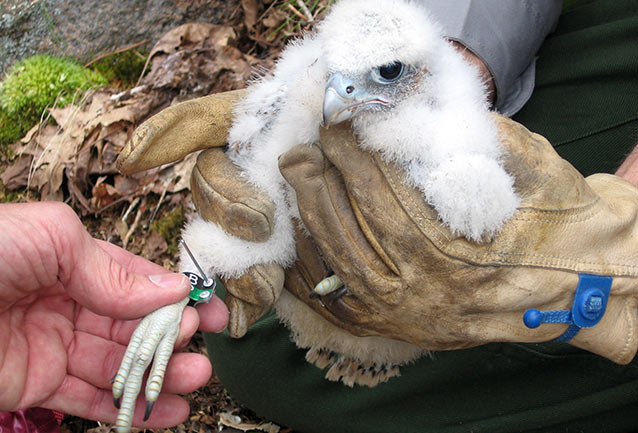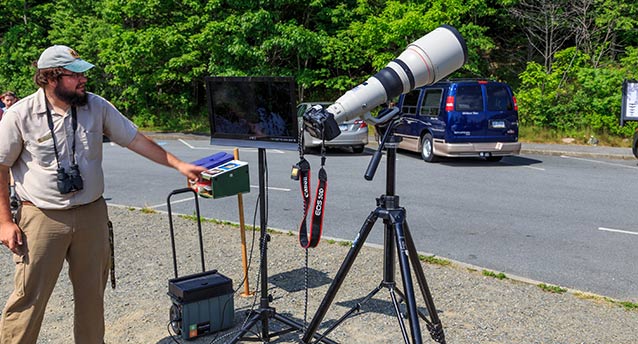For centuries, peregrine falcons hunted the skies of the world, displaying their impressive in-flight hunting tactics. Imagine this crow-sized raptor flying high above its quarry, then diving (“stooping”) to attack prey at a speed of more than 100 miles per hour! Imagine the prey being struck to the ground or even killed in flight by the tremendous impact from the peregrine's outstretched talons! Imagine witnessing a peregrine tail-chasing a dove between Dorr and Cadillac Mountains

NPS/Todd Edgar
By the mid-1960s, researchers determined that peregrines were no longer a breeding species in the eastern United States. Nest robbing, trapping, and shooting first contributed to their downfall, followed in the 1950s by ingestion of chemical pesticides and industrial pollutants. Occupying a position high on the food chain, peregrines are still exposed to high levels of chemical residues if they migrate to or eat migrant song birds from countries using pesticides now banned in the United States. As in other birds of prey, ingested chemical toxins accumulate in their bodies, causing reproductive failure and leading to the decline and eventual endangerment of the species.
Conservation
When Congress passed the Endangered Species Act in 1973, mandating all federal agencies to protect endangered species and their habitats, Acadia National Park responded enthusiastically by participating in a cooperative manage-ment plan to restore a self-sustaining population of peregrines to the eastern United States. The Eastern Peregrine Falcon Reintroduction Program's goal has been to restore the peregrine population to 50 percent of the 350 pairs estimated to have been present in the Eastern United States during the 1940s. This program has been so successful that the peregrine falcon was removed from the federal endangered species list.
The method used to increase falcon popu-lations is the reintroduction of captive-reared chicks into the wild, a process termed “hacking.” Acadia first participated in the hacking program in 1984.
Selected adult birds are bred in captivity. The eggs are incubated and hatched in a laboratory. Chicks three to four weeks old are transferred to a location, called a hack site, where scientists hope to establish a new falcon territory. Once there, to prepare the chicks for release, they are kept several weeks in a protective wooden box with a view of the area.
Hack sites are staffed by trained specialists who carefully monitor, tend, and feed the chicks for approximately three weeks. Attendants observe only from a distance at this time. Food drops are made via a long, sloping tube, preventing the association of food with humans. When their wings are strong enough for flight, fledglings are released. The young falcons continue to eat at the hack site until they learn to hunt on their own.
Peregrines at Acadia
Peregrines nested on Mount Desert Island at least as long ago as 1936. The last known nesting pair was reported in 1956. From 1984 until 1986, 22 peregrine chicks were successfully hacked in Acadia National Park from a high cliff face overlooking Jordan Pond. Adult peregrines often return to areas near their original hack sites, which was the case at Acadia. When an adult peregrine returned in 1987, the park discontinued the hacking program for fear that this adult would prey upon any released chicks.
From 1987 to 1990 adult peregrines returned to Acadia, but did not produce young. The first successful nesting at Acadia in 35 years occurred in 1991. Since that time, at least one and sometimes four pairs have produced young in the park, bringing the total to more than 160 chicks.
Many of the young have been banded to learn about peregrine migration, habitat use, and longevity. Birds banded in the park have been seen in Vermont, Maryland, Washington, D.C., and New Brunswick.
In early spring each year, park resource managers watch intently for signs of returning peregrines. If mating or nesting behavior is observed, certain trails are temporarily closed to avoid disturbance to the nesting area. These measures are helping this magnificent falcon make a triumphant comeback in Acadia National Park and contributing to the success story of the Endangered Species Act.
Behavior
Feeding: Primarily feeds on smaller birds. Hunts most vigorously at dawn and dusk in open areas like shores, marshes, and valleys. Hunting is often accompanied by a series of sharp, aggressive, territorial calls: “kee, kee, kee, kee, kee—kee, kee, kee, kee, kee.” Plucks feathers from the prey as it feeds.
Strikes: Usually in mid-air, knocking the quarry to the ground. Less commonly, it will strike and grab prey and fly away.
Nesting: Mostly on precipitous cliffs, but will also nest under suspension bridges and atop tall city buildings. Eggs are laid on a sand- or gravel-covered ledge with a depression that has been scratched in preparation for the clutch. This area is called a scrape.
Peregrine Watch: What to Look for at the Nesting Cliff

NPS/AYTT
March to Mid-April (courtship)
Adult falcons fly close to each other near the nesting cliff, feeding each other, and perform in-flight acrobatics. The falcons are most vocal at this time. Typical breeding vocalizations are “chup, chup, chip” or “Eeee, chup chup chup chup.”
Mid-April though May (nesting)
One falcon incubates eggs while the other hunts or perches nearby. Adults may exchange food in mid-air.
June
In early June, young falcons may be seen as “tiny white snowballs” at the edge of the nest cliff. Their markings will change as they mature. They may flap their wings to build strength for flight. They take their first flights in late June or early July.
July through August (fledging)
Young falcons practice flight, exploring farther afield. Watch for them flying above the cliff or other parts of the island. They may perch anywhere on the cliff’s ledges or on dead trees.
Fall and Winter (migration)
Some of Acadia’s peregrines may head south for the winter, while others may overwinter in Maine or other areas of New England, depending on the severity of the winter or the availability of prey. Peregrines from Greenland and Canada migrate through Mount Desert Island from August through October.
Field Marks
Wings: Long, pointed, sickle shaped. All falcons in a dive appear to have sickle-shaped wings. Wing shapes depend on the degree to which the bird is soaring or diving. Be careful in making identifications.
Head: Small with dark “sideburns”
Size: Crow-sized, female larger than male
Feet: Large (hence the nickname “big-footed falcon”)
Adult – yellow
Immature – light green
Plumage: Adult – white breast, dark gray back Immature – streaked breast, brown back
What can I do?
Help protect and promote the conservation of peregrine falcons:
- Learn characteristic field marks and behavior to make a positive identification.
- Stay away from areas where peregrines are nesting and report any person who fails to do the same. Avoid observing the birds from a location higher than the nest site. Adult peregrines generally won’t tolerate people above them and may dive at intruders, particularly if they are defending a nest or chicks.
- Observe trail and area closures. The Precipice, East Face, and Jordan Cliffs Trails and the northern section of the Flying Mountain Trail are closed. The Precipice Wall, Valley Cove Wall, Jordan Cliffs, and Beech Cliffs areas are also closed.
Last updated: September 8, 2020
